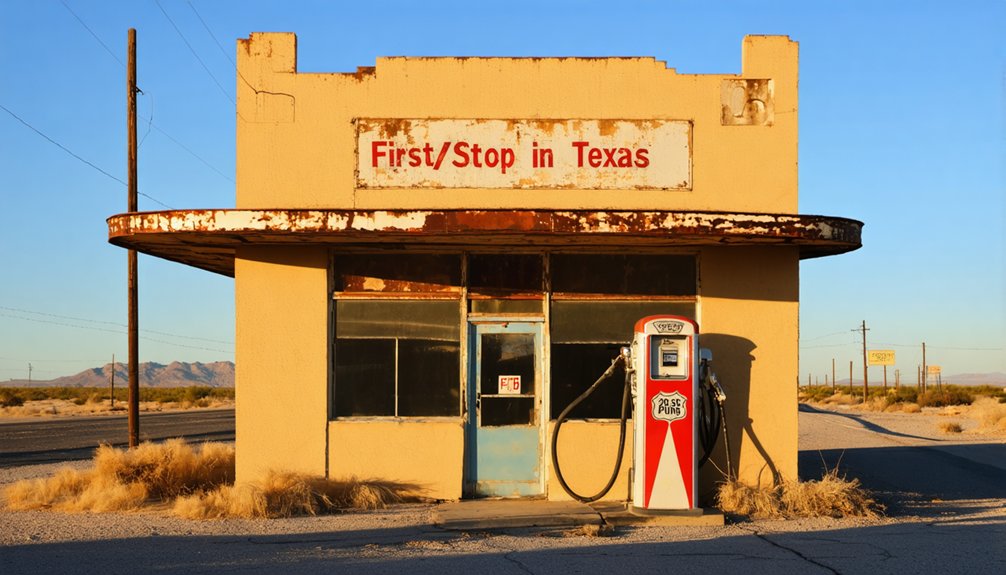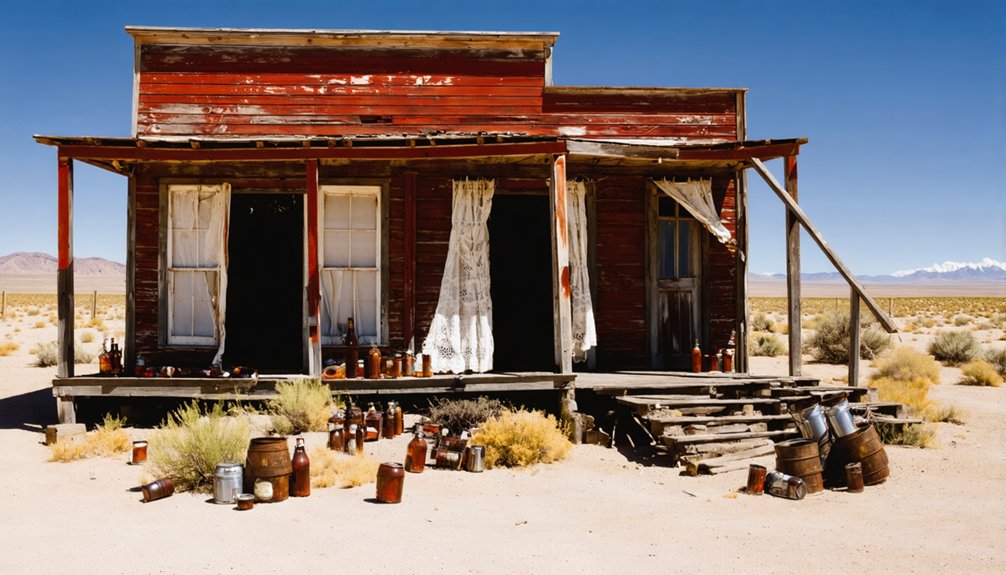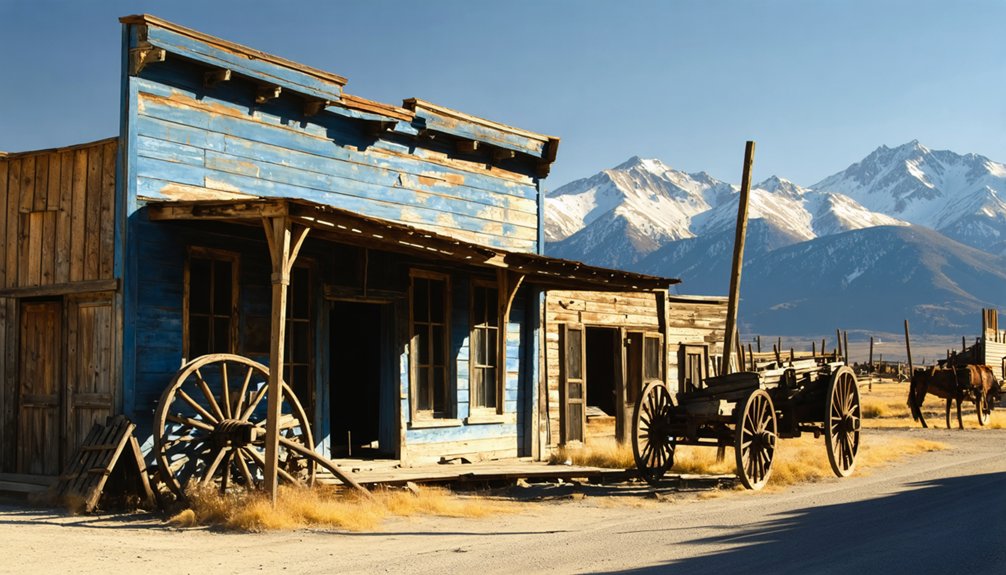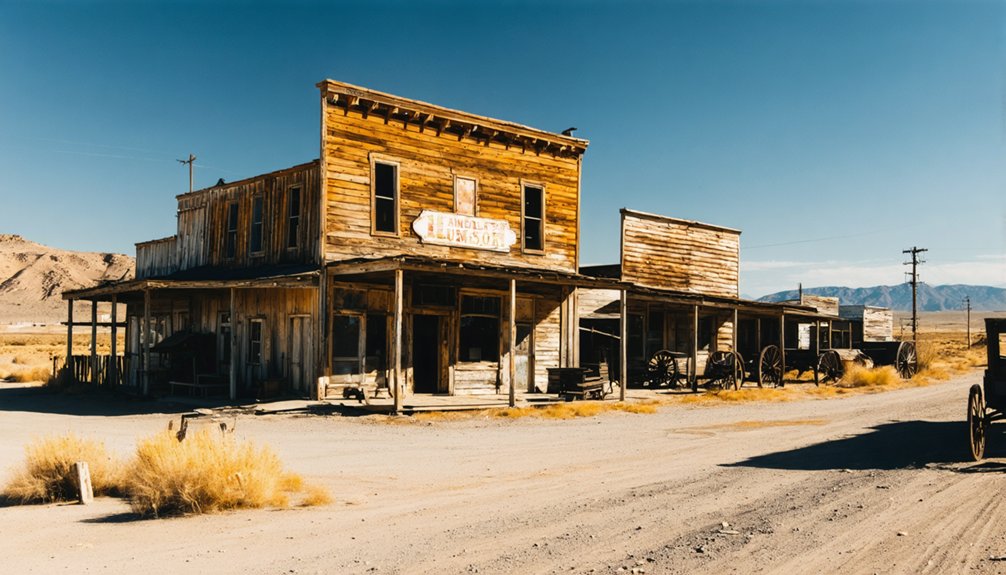You’ll find the American West’s most fascinating ghost towns scattered across rugged landscapes, from Bodie, California’s perfectly preserved gold rush architecture to St. Elmo, Colorado’s mountain railway hub. These abandoned settlements tell tales of fortune and failure through their weathered buildings and empty streets. Kennecott’s copper empire in Alaska, Belmont’s silver-lined Nevada courthouse, and Glenrio’s Route 66 ruins stand as silent witnesses to boom-and-bust cycles. Each dusty doorway and creaking floorboard holds secrets of the Old West‘s most dramatic chapter.
Key Takeaways
- Bodie, California stands as the best-preserved ghost town in America, featuring 100+ original buildings maintained through “arrested decay.”
- St. Elmo, Colorado offers 43 well-preserved historic structures and remains one of the most intact mining towns in the Rocky Mountains.
- Kennecott, Alaska showcases impressive mining innovation with its fourteen-story concentration mill and historic copper mining operations.
- Belmont, Nevada features a remarkable 1876 courthouse and well-preserved architecture from its silver mining heyday.
- Frisco, Utah presents unique beehive-shaped charcoal kilns and a historic cemetery reflecting its violent mining town past.
Bodie, California: The Golden State’s Best-Preserved Mining Town
When four prospectors discovered gold in California’s eastern Sierra foothills in 1859, they couldn’t have known they were founding what would become the state’s most perfectly preserved ghost town.
Named after ill-fated prospector William Bodey, who perished in a blizzard, the town’s misspelled name stuck when a sign painter wrote “Bodie.”
The real gold rush began in 1876, transforming this remote outpost into a booming metropolis of 10,000 souls.
Within months, prospectors and fortune-seekers flooded into Bodie, turning a quiet mountain camp into a bustling city of thousands.
You’ll find over 100 examples of original gold rush architecture frozen in time, thanks to the “arrested decay” preservation method.
While miners extracted $38 million in precious metals, Bodie earned notoriety for its 65 saloons, brothels, and deadly gunfights.
Today, you can explore this National Historic Landmark‘s haunting buildings, still filled with belongings left by residents who never returned. The town’s China Town district thrived with hundreds of Chinese residents who contributed to the community through various trades like laundry and logging.
The town achieved a significant milestone when it became one of the first electrified communities in the United States during the early 1890s.
St. Elmo, Colorado: A Railway Ghost in the Rockies
At the height of its mining heyday in 1880, you’d find St. Elmo teeming with over 2,000 residents who flocked to this Rocky Mountain boomtown within just ten days of its founding.
Today, visitors can explore 43 historic structures that remain standing, offering a remarkable window into Colorado’s mining era. The Denver, South Park & Pacific Railroad served as the town’s lifeline, connecting over 150 mining claims to the outside world and transforming St. Elmo into a bustling hub of gold and silver extraction. The Mary Murphy Mine produced an impressive 50-75 tons of ore each day during peak operations.
You can trace St. Elmo’s decline to the gradual depletion of its precious metals and the 1926 removal of the railroad tracks, which left this once-prosperous mining town increasingly isolated in Chalk Creek Canyon.
Mining Prosperity and Decline
Deep in Colorado’s Chalk Creek Canyon, the story of St. Elmo began in 1875 when prospectors discovered silver deposits near what would become the Mary Murphy Mine.
You’ll find a tale of spectacular rise and fall, as this once-bustling town grew to 2,000 residents during the 1880s mining boom. Advanced mining techniques, including aerial tramways and hydraulic operations, helped extract over 220,000 ounces of gold worth millions. The completion of the Denver, South Park and Pacific Railroad in 1880 further fueled the town’s growth.
Originally called Forest City, the settlement was later renamed to St. Elmo after a popular novel of the time.
But the town’s fortunes wouldn’t last. Devastating fires in the 1890s ravaged the commercial district, while declining ore values struck at the town’s heart.
By 1922, the railroad ceased operations, and most residents had packed up and left.
Today, St. Elmo’s ghost town legacy lives on through its remarkably preserved buildings, standing as silent witnesses to the boom-and-bust cycle that defined the American West.
Railroad’s Critical Role
The arrival of the Denver, South Park and Pacific Railroad in 1881 transformed St. Elmo into a bustling mountain hub of railroad innovation.
You’ll find the railway’s impact etched into every aspect of this once-thriving town, where trains thundered through the Historic Alpine Tunnel, carrying precious cargo and connecting isolated mountain communities.
This economic transformation brought unprecedented prosperity, as the railroad hauled over $60 million in gold from local mines while bringing essential supplies to 2,000 residents.
The Mary Murphy mine became the town’s most profitable operation, generating massive wealth during the peak mining era.
You can still trace the path where tracks once carried fortune-seekers through harsh mountain terrain.
At an elevation of 9,961 feet, St. Elmo remains one of Colorado’s highest ghost towns.
When the railroad ceased operations in 1922, it spelled doom for St. Elmo.
Most residents departed on the final train, leaving behind empty buildings that stand today as silent sentinels of the railroad era.
Kennecott, Alaska: The Copper King of the North
You’ll find a remarkable demonstration of America’s mining prowess at Kennecott, where from 1911 to 1938 some of the world’s purest copper ore yielded $200 million (about $3 billion today) in mineral wealth.
Getting there meant conquering Alaska’s harsh wilderness with a 196-mile railway that connected this remote outpost to civilization through mountains and glaciers. During its heyday, Kennecott became the largest copper mine worldwide. Today, guided mill tours offer visitors unprecedented access to this preserved piece of mining history.
The mine’s success attracted hundreds of workers with top wages, while the Guggenheim and Morgan families transformed their initial $25 million investment into an empire that helped shape America’s industrial age.
Mining Marvel and Money
Nestled against the dramatic backdrop of Alaska’s Kennicott Glacier, Kennecott’s copper mining operation emerged as one of America’s most lucrative mineral ventures after prospectors Clarence Warner and Jack Smith stumbled upon extraordinarily rich copper deposits in 1900.
You’ll marvel at how this remote wilderness site transformed into a mining powerhouse, yielding ore with an astounding 70-85% copper concentration – far surpassing the typical 10% found elsewhere.
This copper legacy generated over 1.3 billion pounds of copper and 280 tons of silver by 1938, worth roughly $4 billion in today’s money.
Through mining innovation, Kennecott’s engineers conquered the harsh terrain with aerial tramways and a fourteen-story concentration mill, while the 196-mile railway to Cordova guaranteed the operation’s success, despite its isolation.
Remote Rugged Railway Access
When construction began on the Copper River & Northwestern Railway in 1908, engineers faced a formidable 196-mile challenge through Alaska’s most treacherous terrain.
You’ll marvel at how they conquered -60° temperatures, glacial floods, and avalanches to forge this remote railway through the wilderness. The rugged access route demanded 28 bridges, including the legendary Million Dollar Bridge, designed to withstand massive ice flows from upstream glaciers.
This lifeline to civilization carried over 600,000 tons of copper ore from Kennecott to Cordova until 1938.
- Trek across the original railway grade, now part of Wrangell-St. Elias National Park
- Explore remnants of historic bridges that survived the 1964 earthquake
- Follow the path along the mighty Copper River and Kennicott Glacier
- Discover engineering feats that defied the impossible
- Stand where trains once braved Alaska’s most challenging landscape
Belmont, Nevada: Silver Strikes and Desert Nights
Silver fever gripped central Nevada in 1865 when prospectors struck rich veins near what would become Belmont.
You’ll find this ghost town‘s architecture remarkably preserved – its brick walls still reaching skyward despite decades of desert winds. The imposing 1876 courthouse stands as the crown jewel among abandoned artifacts, while stripped timber roofs tell tales of resourceful settlers who carried away materials for new ventures.
At its peak, you could’ve joined 2,000 souls in this bustling county seat, ducking into saloons, catching shows at the Cosmopolitan Music Hall, or reading one of two competing newspapers.
Step into Belmont’s golden age, where saloons buzzed and the Cosmopolitan Music Hall echoed with entertainment for 2,000 frontier souls.
The mines yielded $15 million in silver, copper, and antimony before falling silent.
Today, you can wander past the Monitor-Belmont Mill, where World War II pilots once used the ruins for target practice.
Glenrio: A Tale of Two States on Route 66

Straddling the Texas-New Mexico border, Glenrio stands as a peculiar ghost town where you’ll find empty buildings split between two states along historic Route 66.
Established in 1905 as a railroad stop, this once-bustling waypoint served travelers between Amarillo and Tucumcari. State laws created an unusual dynamic: Texas prohibited bars while New Mexico’s high fuel taxes kept gas stations on the Texas side.
By the 1950s, the four-lane highway brought prosperity, though the town never housed more than 30 permanent residents. When Interstate 40 bypassed Glenrio, the steady flow of travelers vanished, leaving behind a haunting collection of abandoned structures.
- Walk the original Route 66 roadbed through the Glenrio Historic District
- Explore abandoned motels, diners, and gas stations frozen in time
- Photograph iconic mid-century commercial architecture
- Stand in two states at once at the Texas-New Mexico border
- Visit filming locations from “The Grapes of Wrath”
Frisco, Utah: Wild West Legacy in the San Francisco Mountains
You’ll discover the untamed spirit of Frisco, Utah, a silver boomtown where daily murders and swift justice shaped its reputation as one of the Great Basin’s most violent settlements in the 1870s and 1880s.
The town’s economic heart, the Horn Silver Mine, produced millions in precious metals before a devastating 1885 cave-in silenced its operations and led to Frisco’s abandonment.
Today, you can explore the haunting remnants of this Wild West outpost, including its distinctive beehive-shaped charcoal kilns that once fueled the mining operations.
Mining and Lawless Past
Deep in Utah’s San Francisco Mountains, the ghost town of Frisco earned its reputation as one of the American West’s most lawless mining settlements.
During its heyday in the 1880s, this wild boomtown witnessed roughly one murder per day while mining techniques extracted over $60 million in precious metals. The Horn Silver Mine dominated the landscape, while frontier justice meant sheriffs were ordered to shoot troublemakers rather than arrest them.
- Explore the remains of five massive beehive charcoal kilns where ore was processed
- Walk among ruins where 23 saloons once fueled the town’s notorious violence
- Visit the historic cemetery, a monument to the town’s deadly reputation
- Discover rusting mining equipment from the $20 million Horn Silver Mine
- Stand where mule trains and railroads once transported valuable ore to distant markets
Historic Kilns Still Standing
Standing as silent sentinels to Utah’s mining legacy, five massive beehive-shaped kilns dominate the Frisco ghost town landscape. Built between 1877 and 1880, these granite monuments soar 26 feet high, with diameters ranging from 16 to 32 feet.
You’ll find them among the earliest and best-preserved examples of kiln technology in the American West. These engineering marvels revolutionized charcoal production for the Horn Silver Mine‘s smelting operations. Local pinyon pine and juniper fueled the kilns, which churned out an astounding 510,000 pounds of charcoal monthly at peak operation.
While 36 other beehive kilns once operated throughout the district, only these five remain as evidence of Frisco’s industrial might. Though the mine’s collapse in 1885 ended their reign, these National Register landmarks still command the desert horizon, drawing visitors to their weathered walls.
The Art of Ghost Town Photography

How can a photographer capture the haunting beauty of America’s abandoned frontier settlements? With the right light techniques and composition strategies, you’ll transform forgotten places into compelling visual stories.
You’ll need a quality camera, versatile lenses, and a sturdy tripod to master ghost town photography. During golden hours, natural light creates dramatic shadows across weathered buildings, while long exposures can capture ethereal effects that bring these abandoned places to life.
- Use manual controls and focus for precise shots in varying light conditions
- Experiment with light painting to create mystical atmospheres
- Capture both wide street scenes and intimate architectural details
- Incorporate reflections and black-and-white processing for mood
- Employ multiple off-camera flashes to enhance depth and reveal hidden features
Remember to respect historical sites as you explore these time-frozen settlements through your lens.
Planning Your Ghost Town Adventure
When commencing a ghost town adventure in the American West, careful planning can make the difference between a memorable expedition and a frustrating ordeal. Start by researching ghost town essentials: accessibility, seasonal conditions, and available services.
You’ll find some sites like Tombstone are tourist-friendly with paved roads, while others demand rugged 4×4 vehicles or hiking boots.
Consider your comfort level when exploring accessibility options. RV camping works well near Virginia City and Tombstone, but remote locations like Kirwin require self-sufficiency and backcountry gear.
Check road conditions, secure necessary permits, and pack offline maps since cell service is unreliable. Don’t forget water, emergency supplies, and weather-appropriate clothing.
For the richest experience, time your visit around special events like Bannack Days or O.K. Corral reenactments.
Safety Tips for Ghost Town Exploration

Safety should be your top priority when visiting abandoned towns of the American West, where hidden dangers lurk beneath weathered facades and crumbling structures.
You’ll need proper safety equipment and group protocols to navigate these historic sites responsibly. Before venturing into these time-worn settlements, make sure you’re equipped for the rugged terrain and unpredictable conditions.
- Don sturdy boots, long sleeves, and gloves to protect against hazardous debris
- Travel in groups of three or more, maintaining constant communication
- Carry essential gear: first-aid kit, flashlight, water, and emergency supplies
- Research potential environmental hazards and obtain necessary permissions
- Map your route and share your plans with someone who isn’t joining the expedition
Preserving America’s Abandoned History
Throughout the American West, countless ghost towns stand as silent witnesses to bygone eras, their preservation vital for understanding our nation’s pioneering spirit.
You’ll find various preservation techniques being employed, from “arrested decay” at Bodie, California, where buildings are stabilized but not restored, to complete renovations like those at St. Elmo, Colorado, where you can still visit a functioning historic post office.
Ghost town tourism has become essential for funding these preservation efforts, with sites like Rhyolite, Nevada, seeing renewed interest through heritage programs.
Organizations like the Bureau of Land Management and state parks departments work alongside historical societies to protect these treasures from weather damage, vandalism, and development pressures.
Through their efforts, you’re able to experience authentic glimpses of frontier life in over sixty preserved buildings at places like Bannack, Montana.
Frequently Asked Questions
Are Ghost Towns Legally Protected From Treasure Hunters and Artifact Collectors?
You’ll face legal implications under federal and state laws protecting ghost towns from unauthorized artifact collection, while preservation efforts restrict treasure hunting unless you obtain proper permits and landowner permissions.
What’s the Best Season to Visit Ghost Towns in Different Regions?
Visit Western Desert towns in summer, Mountain towns from May to October, Pacific Coast sites spring through fall, and Southwestern locations during spring or autumn for ideal exploring conditions.
Do Any Ghost Towns Still Have Active Residents or Caretakers?
You’ll find ghost town demographics vary, with places like St. Elmo hosting 10-15 residents, while others rely on dedicated caretakers who maintain historic structures and manage tourism year-round.
How Accurate Are Ghost Town Population Records From the Mining Era?
While you’d expect precise mining census data, population accuracy was often unreliable due to transient miners, remote locations, and deliberately inflated numbers. Even official records couldn’t fully capture the rapid boom-bust cycles.
Can Visitors Enter Buildings or Is Exploration Limited to Exterior Views?
Building access varies – you’ll find some ghost towns let you enter restored structures, while others restrict you to exterior views. Exploration rules depend on ownership, safety conditions, and preservation needs.
References
- https://www.mentalfloss.com/geography/american-ghost-towns-can-still-walk-through
- https://en.wikipedia.org/wiki/Wikipedia:WikiProject_Ghost_towns
- https://explorethearchive.com/western-ghost-towns
- https://m.dresshead.com/files/scholarship/Documents/Ghost_Towns_Lost_Cities_Of_The_Old_West_Shire_Usa.pdf
- https://www.visitutah.com/things-to-do/history-culture/ghost-towns
- https://www.ghosttowns.com
- https://www.youtube.com/watch?v=SC60gEY39us
- https://noospheregeologic.com/blog/tag/ghost-towns/
- https://www.geotab.com/ghost-towns/
- https://bbb7.lpc.events/papersCollection/publication/fetch.php/Ghost Towns Of The West A Sunset Pictorial.pdf



